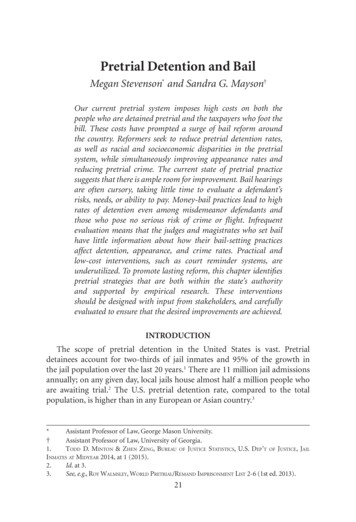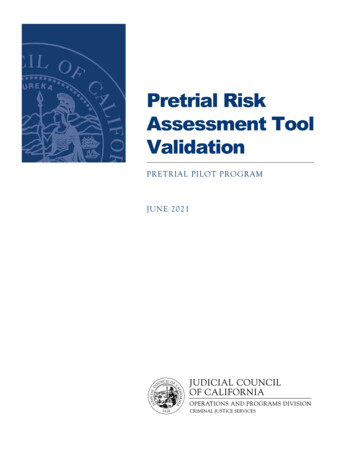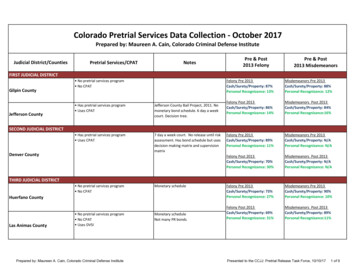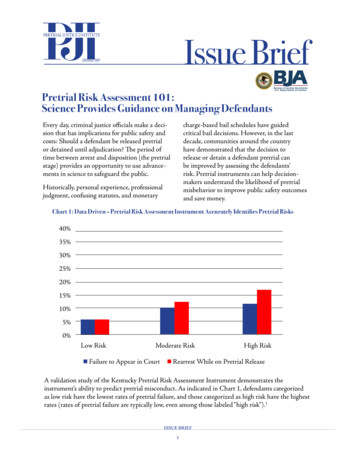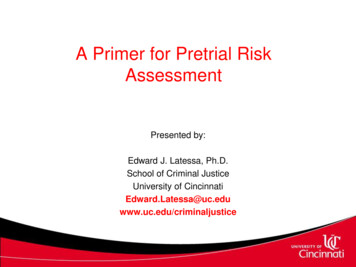
Transcription
A Primer for Pretrial RiskAssessmentPresented by:Edward J. Latessa, Ph.D.School of Criminal JusticeUniversity of justice
Over 30 years of Research in Assessment hasIndentified some Important Principles Risk (Who) Need (What)
Let’s Start with the Risk PrincipleRisk refers to risk of reoffending andnot the seriousness of the offense.
Risk PrincipleAs a general rule treatment effects are stronger ifwe target higher risk offenders, and harm can bedone to low risk offenders
Risk Level by Recidivism for the CommunitySupervision Sample80Low RiskMedium RiskHigh RiskVery High RiskPercent with New Arrest7069.258.960504034.33020109.10Low 0-14Medium 15-23High 24-33Very High 34
Intensive Intervention for Low RiskOffenders will Often Increase Failure Rates Low risk offenders will learn anti socialbehavior from higher risk Disrupts pro-social networks Increased reporting/surveillance leads tomore violations/revocations
Study of Intensive Rehabilitation Supervision in Canada60504030RecidivismRates20100High RiskLow RiskTreatmentNon-Treatment31.632.351.114.5Bonta, J et al., 2000. A Quasi-Experimental Evaluation of an Intensive Rehabilitation Supervision Program., Vol. 27 No 3:312-329. Criminal Justice andBehavior
STUDY OF COMMUNITY CORRECTIONALPROGRAMS IN OHIO Largest study of community based correctionaltreatment facilities ever done up to that time. Total of 13,221 offenders – 37 Halfway Houses and 15Community Based Correctional Facilities (CBCFs) wereincluded in the study. Two-year follow-up conducted on all offenders Recidivism measures included new arrests &incarceration in a state penal institution
ReducedRecidivismIncreasedRecidivism
202-6 -5-10-18-20653339 10 10887101512 12 12 13 13 130-2 -2-15 -14Probability of ReincarcerationTreatment Effects For High Risk Offenders4021 2224 252730343032-30-40-34nioatciysontAsouns yCC ng Ctio rmmEO ni A ec Aronraah VO or ioogM o y C vatPrdyle nit SalncTo mu ghtdeanm LimenCo or g eek eek eprb ru B Cr l DHa p D use m icam Ho lu emCo ert se A Chlb ou A CTa s H VO MRvi ati TAl n seniunc o sCi na H gramsia ro ty ionOr ll P oun nsita C raSm klin ty Tan niFr mumCo TAPtySE r un umtle Co ingrteBu mit uskenm /MtCSu ing esienck littmLi acieaTrlFAl CC nty nityC ou uSR C m esismtca o ililCalLu on FacHgnt F aCa BC din nninlC e uAl n/M e DPira ous RIve lro alLo H seHuGsngvi o)Al a Hrin aho’spnia P S MenOr A se Mc(MOC Hou AamNE rt VOgrerolb atitPTa innenncsm neCi RTHes toss ersOW day ty A ornon ni CM mu use ncym Ho geCo ert e Alb ivTa rnat tte arAl h Stes ityFr r CveRi
The Risk Principle and Pretrial Release Van Nostrand and Keebler (2009) found thatwhen lower risk defendants were released toconditions that included alternatives todetention, they were more likely experiencepretrial failure. These defendants were, in effect, oversupervised given their risk level.VanNostrand, M., and G. Keebler (2009) Pretrial Risk Assessment in Federal Court. Federal Probation. Vol. 72 (2).
To understand the Need Principle we needto review the body of knowledge related torisk factorsWhat are the risk factors correlated withcriminal conduct?
Major Set of Risk Factors1.Anti-social/pro-criminal attitudes, values, beliefs andcognitive emotional states.2.Pro-criminal associates and isolation from anti-criminalothers.3.Temperamental and anti-social personality patternsconducive to criminal activity including: Weak socialization Impulsivity Adventurous Restless and aggressive Egocentrism Risk-taking Weak problem-solving, self-regulation & coping skills4.A history of anti-social behavior.
Major Set Continued5.6.7.8.Familial factors that include criminality and a variety ofpsychological problems including: Low levels of affection, caring, and cohesiveness Poor parental supervision and discipline practices Outright neglect and abuseLow levels of personal, educational, vocational, orfinancial achievement.Low levels of involvement in pro-social leisure activities.Substance abuse.
Assessment is the engine that driveseffective correctional programs Need to meet the risk and need principle Can help reduce bias Aids decision making Best risk assessment method is theactuarial (statistical) approach
Comparison of Clinical vs. StatisticalPrediction of Recidivism0.240.220.2r value0.180.160.140.120.10.080.060.040.020General RecidivismClinicalStatistical0.080.22Goggin, C.E. (1994). Clinical versus Actuarial Prediction: A Meta-analysis. Unpublished manuscript. University of New Brunswick, SaintJohn, New Brunswick.
To Understand Assessment it isImportant to Understand Types of RiskFactors
Dynamic and Static Factors Static Factors are those factors that arerelated to risk and do not change. Someexamples might be number of prioroffenses, whether an offender has everhad a drug/alcohol problem. Dynamic factors relate to risk and canchange. Some examples are whether anoffender is currently unemployed orcurrently has a drug/alcohol problem.
There are two types of dynamicrisk factors Acute – Can change quickly Stable – Take longer to change
According to the American Heart Association, there are anumber of risk factors that increase your chances of a firstheart attack Family history of heart attacks Gender (males) Age (over 50) Inactive lifestyle Over weight High blood pressure Smoking High Cholesterol level
Some Examples of OffenderRisk Assessment Tools Level of Service Inventory (LSI) COMPAS Ohio Risk Assessment System
One New Non-ProprietarySystem is the ORASThe Ohio Risk Assessment System (ORAS)consists of 6 basic tools:1. Pre-Trial Tool (ORAS-PAT)2. Misdemeanor Assessment Tool (ORAS-MAT)3. Community Supervision Assessment Tool (ORAS-CST)4. Prison Intake Screening Tool (ORAS-PST)5. Prison Intake Tool (ORAS-PIT)6. Reentry Tool (ORAS-RT)
ORAS-Community SupervisionTool Intake Assessment
Challenges of Developing PretrialAssessment Tools There have been hundreds of studies ofcriminal behavior over many years,involving thousands of offenders that havefound great deal of consistency withregard to the basic domains of risk The challenges with pretrial are fairlyunique and is probably the reason thatthere is so much consistency betweenpretrial assessment tools
Some Methodological and PracticalIssues in Developing Pretrial AssessmentAll the problems normally associated with developing assessment toolsplus: Quality and availability of data Difficult to do random assignment and result is skewed sample – manyhigh risk/serious defendants are not granted pretrial release Generally we are concerned about outcomes during the pretrial releaseperiod: result is short follow-up and low base rates of failure Legal status limits type of information that can be gathered Time constraints for assessment Two outcomes: FTA and New Arrests
Pretrial Assessment There are a number of assessment toolsavailable and most find similar predictors
The Most Common Items in PretrialAssessment Tools Prior FTAsPrior ConvictionsPresent Charge a FelonyBeing EmployedHistory of Drug UseHaving a Pending Case
Other Common Items Prior IncarcerationsCommunity Ties and Residential StabilitySubstance UseEducationAge
ORAS- PAT Like most it is short Non-proprietary Minimal Training
PRETRIAL ASSESSMENT TOOLNAME:CASE NUMBER:BOND AMOUNT:DATE OF OFFENSE:DATE OF ASSESSMENT:COURT DATE:Verified1. What was the age of the defendant at first arrest. If unknown, use first conviction0 If the defendant was 33 or older1 If the defendant was 32 or younger2. How many failure to appear warrants have been filed in the last 24 months0 None1 A single failure to appear in the last 24 months2 Two or more failure to appears in the last 24 months3. Did the defendant have three or more prior jail incarcerations?0 No1 YesNumber of Prior Prison incarcerations:4. Was the defendant employed at the time of arrest?0 Defendant is employed full time/disabled/retired/student (31 hours)1 Defendant is employed part time (10-30 hours)2 Defendant is unemployedDefendant on public welfare?:Job start date was within 6 months:5. Any illegal drug use in the last 6 months0 No1 Yes6. Defendant self reported severe drug related problems0 No (1-3)1 Yes (4-5)7. Has the Defendant lived at the current residence for 6 months or more?0 Yes1 NoIs the current residence within the assessor’s jurisdiction?Risk Level0-2 Low3-5 Medium6 HighTOTAL SCORE
Cutoffs: Any ViolationFailure Rate of es in Recidivism Rates for each Risk Level(n 452)
Percentage in Each Risk Category
Public Safety Assessment Court(PSA-Court) Developed by the Arnold Foundation Use data from KY to compare non-interview datato interview-based assessment – found noninterview was just as predictive Next looked a 745,525 cases and three outcomes(1) new criminal activity (2) FTA and (3) newviolent criminal activity Identified nine factors (all criminal history based)and adding interview based did not improve riskassessment performance
Factors in the PSA Age at current arrest (NCA)Current violent offense (NVCA)Current violent offense & 20 years old or younger (NVCA)Pending charge at the time of the offense (FTA, NCA, NVCA)Prior misdemeanor conviction (NCA)Prior felony conviction (NCA)Prior conviction misdemeanor or felony (NCA, NVCA)Prior violent conviction (NCA, NVCA)Prior failure to appear in the past two years (FTA, NCA)Prior failure to appear older than two years (FTA)Prior sentence to incarceration (NCA)
Subjective vs. Objective Pretrial Process NIJ found when subjective process is usedversus objective, jail population nearlydoubles Others have found that use of a tool leadsto more recommendations of releaseNational Institute of Justice (2001). Pretrial services programming at the start of the 21st century: A survey of pretrial services programs.Washington, DC: US Dept. of Justice; Cooprider, K. (2009). Pretrial risk assessment and case classification: A case study. FederalProbation, 73(1), 12-15.
Some Observations For traditional Pretrial programs (looking atFTA or risk of reoffending):– Most tools are similar– Short and sweet– Sort fairly well For Pretrial programs that want to provideservices (i.e. place in drug court)– Most of the existing general assessmenttools will do just fine (i.e. LSI, ORAS-CST, orCOMPAS)
Research on the Effects of Supervised Pretrial Interventionis still Evolving but some Findings Include: Use of quantitative or mixed quantitative-qualitative riskassessments lowers a defendant’s likelihood of pretrialmisconduct Ability to impose sanctions and reports to courts isassociated with less pretrial misconduct The more ways a pretrial program has to follow-up anFTA, the lower the likelihood of a defendant’s pretrialmisconduct Some evidence that providing reminders can reduceFTA although evidence is mixedLevin, D. (2007) Examining the Efficacy of Pretrial Release Conditions, Sanctions and Screening with the State Court Processing Statistics DataSeries. Paper Prepared for the Presentation at the Annual Meeting of the American Society of Criminology, Atlanta, GA.
Other Findings Few studies on use of electronic monitoring, but noconclusive evidence that it is effective in reducing FTAsor new arrests Studies on requiring substance abuse testing andtreatment have found no difference in failure rates forhigher risk defendants, but lower risk appear to do better Use of targeted mental health screening lowers adefendant’s likelihood of pretrial misconduct - butrequiring mental health treatment does not appear tomatterVan Nostrand, M., et al. (2011). State of the science of pretrial recommendations and supervision. Pretrial Justice Institute; Van Nostrand,M., & Keebler, G. (2009). Pretrial risk assessment in the federal court. Washington: Office of Federal Detention Trustee.
FTA Rates Vary tremendously across jurisdiction Estimates low as 5% to high of 25% andno real average or acceptable rate Differences can be explained by systemicdifference – i.e. geographic, political,capacity) and CJS may use differentpractices and notification methods
Many have Implemented CourtNotification Systems Historically most were phone calls or apost card With few exceptions most studies shownotification by phone or mail hassignificantly reduced FTAs (4% to 25%) Most of this research has focused onoverall effectiveness of notification, nottype or timing
Research on Court Notification Systems Bornstein et al study in Nebraska looked at 4 conditions:––––Basic reminderReminder with sanctionsReminder with sanctions and benefits of showing upNo reminder Found that Reminder with Sanctions had the lowest rate(8.3%) versus control (12.6%), but low to begin with They also looked at: race/ethnicitysexgeographic location (specifically, rural vs. urban counties)offense typenumber of chargesBornstein, Tomkins and Neeley (2011)Reducing Courts’ Failure to Appear Rate: A Procedural Justice Approach, Washington, DC: Office ofJustice Programs
Findings by Other Factors FTA rates were:– 11.7% Whites– 18.7% Blacks– 10.5% HispanicsAfter controlling for offense type and number of charges differences werenot significant FTA rates varied by type and number of offenses:– Rates were higher for more serious charges & for those with multiple charges– 1 offense (5.4%)– 2 or more (15.4%) Rates did not differ significantly by sex– Male (10.8%)– Female (9.4%) Rates did vary by location:– urban (12.4%)– rural counties (6.8%)
They also Found that InstitutionalConfidence made a Difference Those with less confidence and more cynicism in theCourt had higher FTA rates Whites had more dispositional trust than non-whites, andBlacks had less trust in the courts than Whites andHispanics They also found that a reminder was more effective fordefendants relatively low in trust.
Research on Methods of Notification Most have used phone (calls or texts) orpostcards, however recent studies suggesttext messages are more effective May be due to what is called “open rate” –rate at which electronic message isopened: text as high as 98%, email 22%(Frost and Sullivan, 2010).Frost & Sullivan (2010). Transformational Health. San Antonio, TX.
Studies on Timing Few studies on effects of timing ofnotification. Most from health field. Downer, et al., found that text messageswithin 3 days prior to appointment reducedrates of missed appointments by 9%. Foley & O’Neil found rates of FTA forappointments dropped by 13% if theyreceived text message within 24 hours.Downer, S., Meara, J. & DaCosta, A. (2010). The impact of short message service text messages sent as appointment reminders topatient’s cell phones at outpatient clinics in Sao Paula, Brazil, International Journal of Medical Information, 79(1):65-70; Foley, J., andO’Neil, M. (2009). Use of mobile telephone short message service as a reminder: The effects on patient attendance. European Archivesof Paediatric Dentistry (10)1, 15-18.
Recent Study Comparing Different StrategiesLowenkamp & Holsinger (2017) Randomized study of over 10,000 cases from Kentucky Five groups–––––CallCall with WarningNoneTextText Warning No significant differences but rates were low across theboard CallCall w/WarningNoneTextText w/Warning12%12%13%11%12%Lowenkamp, C. T., & Holsinger, A. M. (2017). Assessing the effects of court date notification within Pretrial Case Processing. American Journalof Criminal Justice.
Some Challenges Time Constraints and Practicality ofAssessment Money Bail Schedules Local Capacity (i.e. programs, validation oftools, etc.) Subjective Assessment Court Culture and Judicial Behavior
Implementing Assessment What do I want to use it for?Length of time needed to completeTrainingCostComplexityWhen will it be done?Where will it be done?Who will do it?Level of staff commitmentIs assessment reliable?Is assessment valid?
ValidationValidating means it is measuring what youthink it is measuring
Reliability Are staff consistent in scoring?– Inter-rater reliability Training Experience
Pretrial Detention is a Hotly Contested Issue The empirical research that has been conducted to-date issometimes inconsistent, and contradictory, and there are challengesthat limit academic and methodological rigor. While validated risk assessment tools can help courts makedecisions about pretrial release, they are not fool proof. These tools often place defendants into risk categories: “low”,“moderate” or “high” for likelihood to fail-to-appear or continuedcriminal behavior, however, seriousness of the current charge is acommonly used factor that courts take into consideration whenmaking pretrial decisions. In essence, seriousness often trumpsrisk. Finally, until additional well designed studies are conducted,conclusions about the effects of pretrial detention are speculative atbest.
2017 Meta analysis of pretrial research that examined riskassessment, bond type and intervention. Despite finding a total of 811 manuscripts after applying criteria togauge the rigor of the study the number fell to 16 studiesrepresenting over 391,000 defendants. The authors concluded that, “Overall, the quality of the research thatcould be included in the current analysis was not very good, withsome noted exceptions.” While noting that the results should be viewed with caution, theyconcluded that “It appears that more restrictive bond types areassociated with lower FTA rates”. They did place more confidence in the finding that court notificationreduced FTA rates.
Some things to remember There is no “one size fits all” assessment tool– some domains or types of offenders will require specialized assessments(such as sex offenders or domestic violence)– use or purpose will vary Actuarial assessment is more accurate than clinicalassessment, but no process is perfect Assessment helps guide decisions, doesn’t make them -professional discretion is part of good assessment Reliability is more difficult to achieve with dynamic instruments –requires training of staff and continual monitoring of assessmentprocess
The Ohio Risk Assessment System (ORAS) consists of 6 basic tools: 1. Pre-Trial Tool (ORAS-PAT) 2. Misdemeanor Assessment Tool (ORAS-MAT) . Pretrial risk assessment and case classification: A case study. Federal Probation, 73(1), 12-15. Some Observations For traditional Pretrial programs (looking at FTA or risk of reoffending): -Most .
